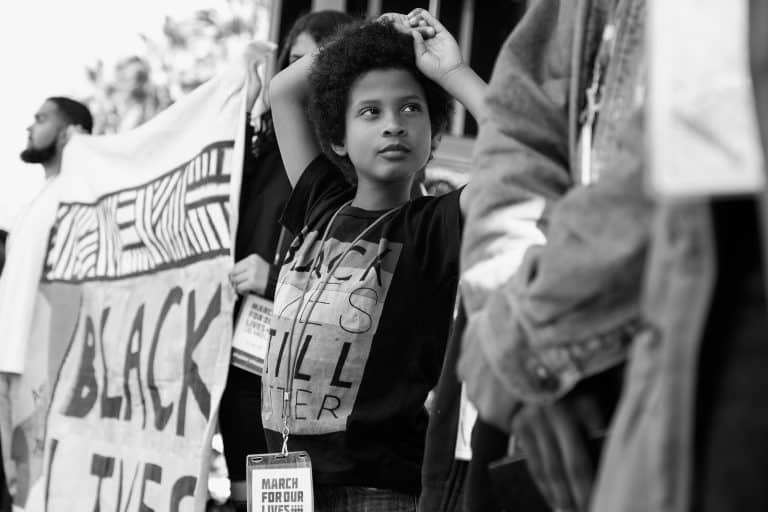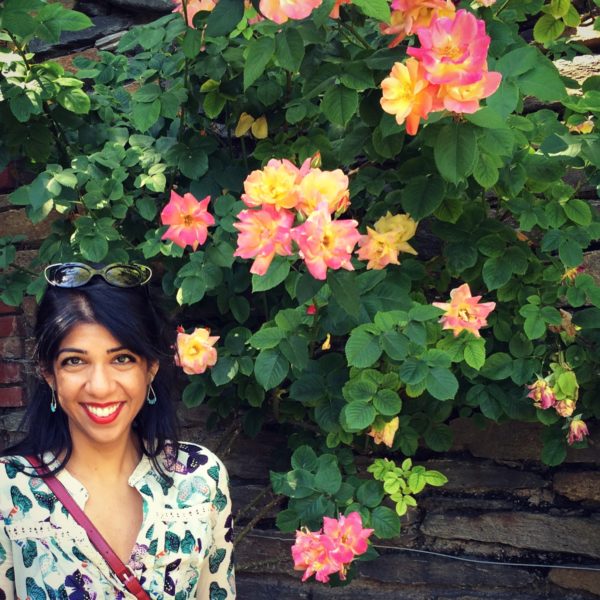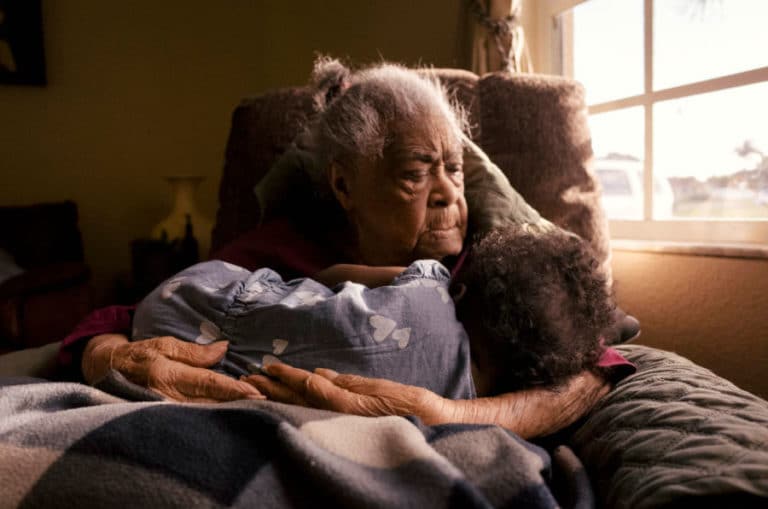
A young Black Lives Matter activist participates in the March for Our Lives Los Angeles rally on March 24, 2018 in Los Angeles, California. Image by Sarah Morris/Getty Images, © All Rights Reserved.
We Must Reckon with the Terrible Realities Hidden in Plain Sight
I teach international relations classes. The first thing I teach most students is Max Weber’s definition of the state — the disciplinary way of understanding what in casual speech we call countries. The state, they learn, is defined by violence — it guards for itself the means of violence; it deems what violence is and isn’t legitimate. The young black men in my classrooms have, in large part, found this concept intuitive; what could I really say to them that would shake the understanding that the state polices, the state kills, and the state finds its agents acted appropriately in taking lives? Students from authoritarian states, or whose families fled civil war, similarly require little convincing.
For students from more comfortable backgrounds, the concept can prove harder to grasp. How could a social order founded on violence inspire such deep affinity? So we turn to Thomas Hobbes, and we talk about the Leviathan — the biblical sea monster that Hobbes uses as his metaphor for the state. The world is violent, Hobbes tells us — so we surrender our rights to a sovereign, and in exchange the sovereign protects us, and even if some sovereigns devolve some of our rights back to us in the bargain, they might reclaim them if the security of the whole requires it.
Teaching the state this way is a process of denaturalization: You reach into the placid waters, you grasp a tentacle, and you drag out a horror that from the surface appeared to be nothing more than weeds. And once the Leviathan rises from the sea for us — once the state has exposed the implicit promise of violence that lies at its heart — how can we forget what it is?
So it is for me as a woman today. The mass reckoning with sexual harassment, violent misogyny, and its inextricability from power structures is no surprise. And yet — as it’s exposed for what it is in a process that I welcome and have worked to precipitate whenever possible — I’ve found myself struggling to recover a sense I had of being a woman that wasn’t forged by inequity, by white supremacy, by misogyny, by patriarchy. Over the last year, I have thought, again and again, of David Foster Wallace’s famous speech “This Is Water.” Wallace tells the story of two young fish swimming along when they meet an older fish “who nods at them and says ‘Morning, boys, how’s the water?’ And the two young fish swim on for a bit, and then eventually one of them looks over at the other and goes, ‘What the hell is water?’”
“The immediate point of the fish story,” Wallace writes, “is that the most obvious, ubiquitous, important realities are often the ones that are the hardest to see and talk about.” “What is so real and essential,” he writes, “so hidden in plain sight all around us, that we have to keep reminding ourselves, over and over: ‘This is water, this is water.’ It is unimaginably hard to do this, to stay conscious and alive, day in and day out.”
And indeed, over the last sixteen months, the stories that nearly every woman has heard repeatedly since she was too young to understand them, the stories that lay bare the strange, sublimated daily nightmare of our lives, have for me taken on the simultaneously surreal and hyper-real quality that the ocean must have for the reflective fish. Because a second serpent’s entwined and submerged with the first: The Leviathan state swims with the violence of daily life for women in a misogynist society. Wrestling it from the water has long been the work of feminist activists; today, seeing it heaved onto the shore, some people are shocked to learn it was ever there. Through certain lenses, it’s remarkably hard to see. Some of us are appalled because it’s hard to look at it again and again, when you know full well its reach and its terrible power.
The structure of everyday violence against women is reflected in the battlements we build to protect ourselves: the little accommodations, the things you do reflexively to keep yourself from being hurt while you walk around, all the subtle ways you protect yourself from being alone with some men in offices and other men in cars and all unknown men in large empty buildings; some of the men you know; the strange men you don’t know; every single dark stairwell; the lurking danger of being cornered in a bar or followed on the street or spat at or having a lit cigarette thrown at you while you walk your dog at 10 p.m. on a Sunday night in the middle of Manhattan; the raised eyebrow when someone hears you were out alone at 10 p.m. on a Sunday night in the middle of Manhattan; the voice shouting at you in a meeting, because how dare you speak; the constant knowledge that your time is weighed cheaply and your work will always be discounted, so you will have to do twice as much of it; every taxi you’ve ever taken instead of walking through the park; every time you’ve ignored the lewd comment from a man on the street or at a bar or at a party, because who knows what he’ll do if you lash out; the strange gift of a week in which a stranger doesn’t call you a bitch for not smiling at him on the street; the quick scan of a subway car when the train pulls into the station to ensure that there are enough people so you won’t be alone if someone threatens you, but not so many people that you’ll get groped without being able to place the hands — a thousand transgressions so small and so regular that you never name them to anyone, even while you decry structural inequality, even when you work to advance a feminist agenda, because that’s just the way life is.
Toxic patriarchy poisons every well: This is water.
In Kazuo Ishiguro’s The Buried Giant, an uneasy peace reigns alongside mass amnesia in a once war-stricken land. Saxons and Britons in post-Arthurian Britain no longer fight one another in Ishiguro’s fable — enmity has faded for people, but so too have the loves and sorrows and knowledge of who they were before a strange, obscuring mist enveloped their lives. Forgetfulness is its own danger, even when some things are too hard to look at. Perhaps living life in a system that says your life is less-than rests in part on a similar amnesia: You may know restive danger undergirds every part of your life and forget it often enough to keep going.
Even buried, the beast is a burden. But it’s daily, necessarily dragged up now, and many well-intentioned men are shocked at its reach; submerged, for many of them, the beast wasn’t necessarily too hard to look at — it was somehow just hard to see. Most of us of course always knew it was there, the most marginalized of us shouldering its full weight, but even the most privileged of us in its shadow. To see it in bright light is shocking, but somehow not as shocking as knowing it was always there and somehow you — vigilant, feminist you — not only grew used to it, but grew to accommodate it. The full shape of it was always obscured by whisper networks and clever parries and the complete sheathing of yourself in a highly polished, completely impenetrable shell whenever possible. Wrenched suddenly to the surface, every long arm squelching against the ground, every tentacle sucking at the air, the enormity of it is overwhelming — but so too is the revelation of how I’ve been shaped by it, how frequently I ceased to see it, and how I’m struggling to conceive of what being a woman would be like in its absence.
After all the long, hard work of making the structure visible, of pointing at the still sea and calling it danger, nothing — not hope from the civil rights advances we have made in the last half-century, not the grim pride of watching brave activists at work, not even the consuming joy of being embraced as an equal through the night, can lessen the weight of it. The pervasive violence in which we have lived has made accounting for danger simply the daily tax of life, and it is fundamental to even my joyful heart and extremely privileged experience in life. What are basic human interactions, if they’re not prefaced by instructions about how not to get molested as a school child, and how not to get raped as an adult, and how not to let harassment derail your career as a professional? And how could even an avowed feminist be overwhelmed now by the scope and scale of this deeply perverse, completely normal way to have lived?
To see this deeply perverse, completely normal way to have lived changing is surreal, triumphant, and disorienting; to truly appreciate the extent to which the love and trust in your life have been the exception rather than the rule is appalling. I’ve been seething with anger below the surface of everything for sixteen months — but how was I not incandescent with rage all the time before that? How could I have been incandescent with rage all the time before that? Is it possible to be a whole person, when your life has been so shaped? That equality and love flourish in some relationships is reassuring. But structurally, professionally, publicly, how can I function with constant consciousness of the violence that shapes my life? How can I function without it?
Left unable to parse the contours of my own experience separate from these structures of oppression, I have turned to the anger of younger women, instead. To say that in youth lies our salvation is a cliché of the worst kind, but it’s one that’s borne out both by spending even a little time in a classroom, and by the mass social movements spearheaded by young people in both this century and the last one, from the civil rights movement to Black Lives Matter to the recent extraordinary organizing against gun violence.
In her obituary of Maurice Sendak, Margalit Fox wrote that Sendak captured “the propulsive abandon and the pervasive melancholy of children’s interior lives;” that children are capable of productive anger should come as no surprise when we task them with strange, difficult learning about bonds and bondages and the rules and strictures of society, or when we consider the slow horror of realizing that to be identified as a woman is to be constrained by others into specific, subservient roles. No one who had lived through that process could really be surprised that Teen Vogue emerged as an early clarion voice against the Trump administration — after all, who could experience all that for the first time without thinking, what the hell is this?
I’ve been particularly taken by the propulsive anger in a remarkable video filmed for International Day of the Girl 2017. I’ve returned to it again and again when I need to navigate the distance between seeing and not seeing the violence around me. In the video, a dozen little girls, mostly brown and black, all small and angry, command the camera, sing and dance along to Beyoncé’s “Freedom,” and demonstrate a rarely-seen public rage at all the inequalities they will face in their lives. Heroines of a story they never asked to be cast in, they trade off mouthing lines in scenes that cut across continents, all of their delivery barbed and ferocious:
“Tryna rain, tryna rain on the thunder / Tell the storm I’m new / I’ma walk, I’ma march on the regular, painting white flags blue,” they sing; “I’ma wade, I’ma wave through the waters; Tell the tide, ‘Don’t move.’”
Their anger is clarifying; it’s clear that theirs is, to borrow Ijeoma Oluo’s words, “not a rage that consumes, that immolates. It’s a rage that fuels, that arms.” Perhaps it helps that a number of the girls even look like I did as a little girl, dark-skinned and watchful, but I think, more than anything, I’m drawn to watch them when I feel overwhelmed by this moment we’re in because very few people have so clearly telegraphed how I want to feel. Throughout the video, girls strike down at the ground, and the camera moves as if with the force of their anger. One girl in particular sticks with me — she is dancing in front of the White House, and the camera cuts to her just as Beyoncé sings, “I’ma riot, I’ma riot through your borders / call me bulletproof.” The camera shift diagonally as she stamps down a foot — and just like that, the White House spins on its side, all the power in her leveraged to tilt the horizon: There lies all the possibility in the world.
Watching these girls and their “rage that fuels,” it seems clear that there is no way to unsee the enormity of the violence, no way to bridge the necessary consciousness of it and the necessary blindness to it, except to do exactly what these girls are doing, what students against gun violence are attempting to do when they refuse to let us normalize mass death by automatic rifles, what Black Lives Matter activists do when they assert that the state’s power to take lives should not go unremarked — to keep pointing to the water and to say, maybe what the monster has made me will force you to see this calm surface as terror.
Being constantly reminded of the violence that undergirds social order — having to look at it again and again — may never become easier for those who experience it — but making it ever-clearer for those who simply could not see it is a vital task of the moment. Tell the tide we won’t move.


Share your reflection